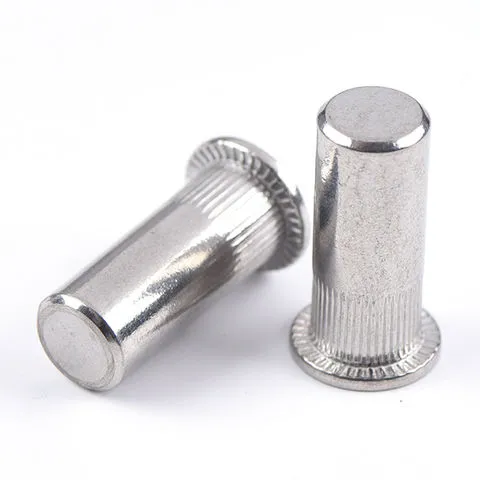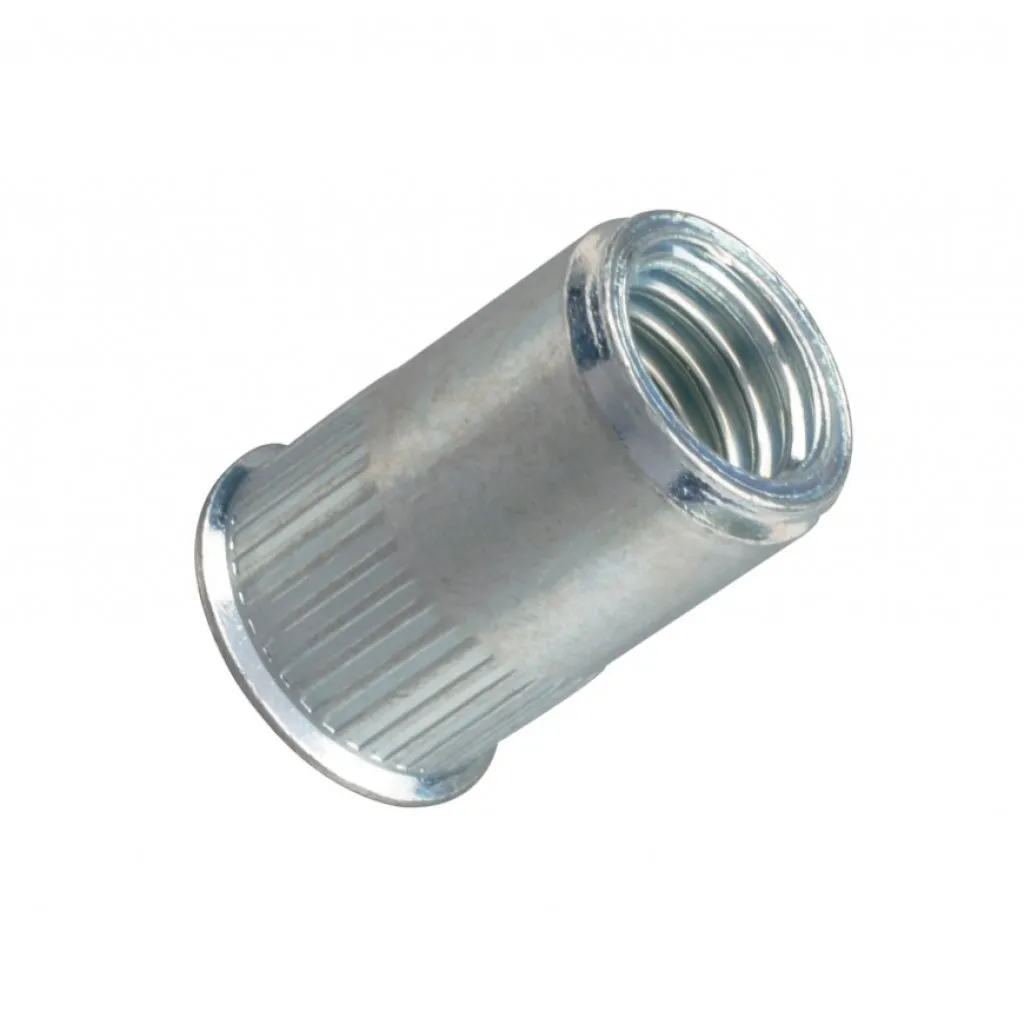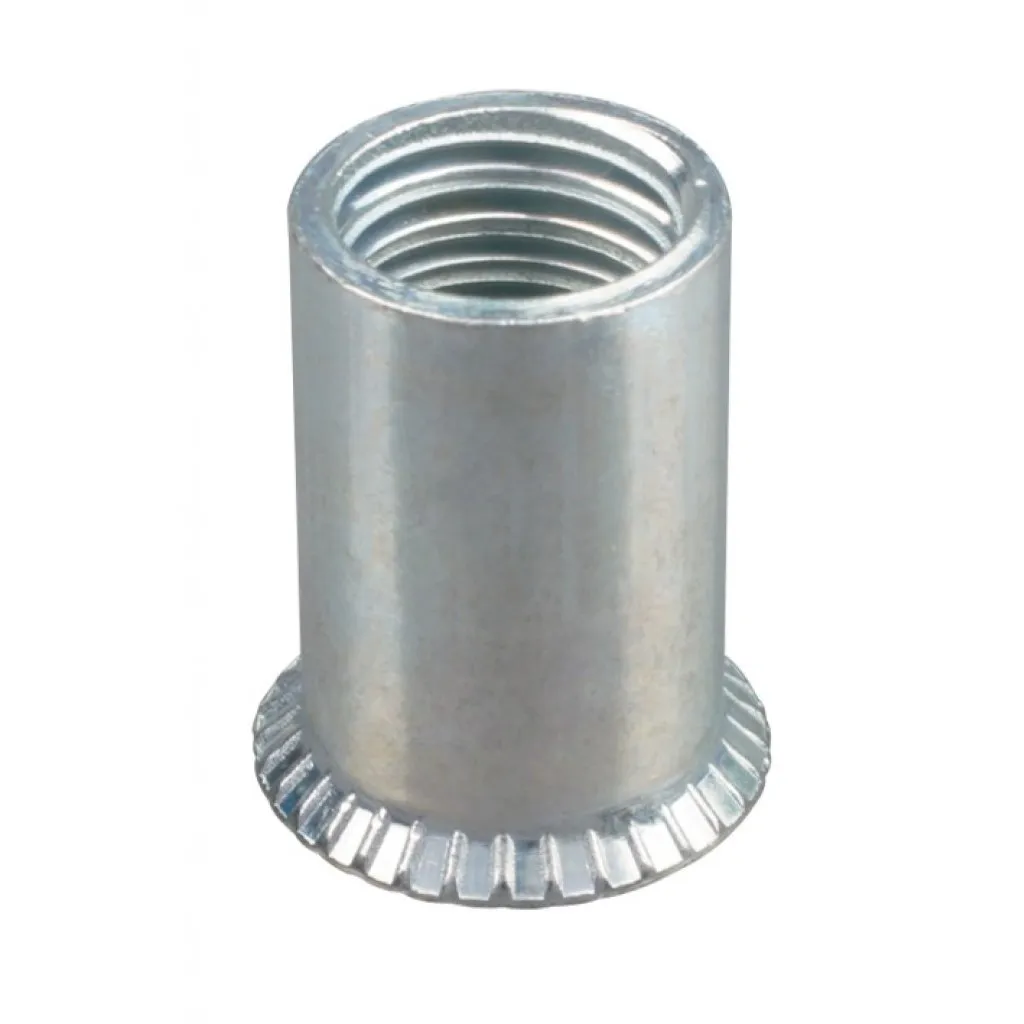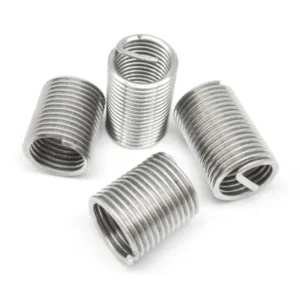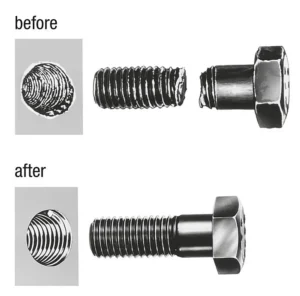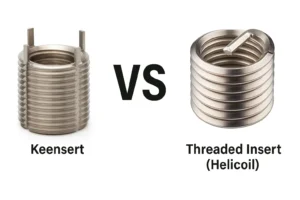What Is the Minimum Thickness for a Rivet Nut?
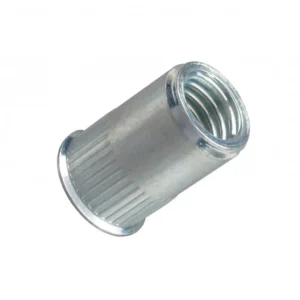
Leading Rivet Nut Manufacturer and Supplier in China

When working with sheet metal or thin-walled materials, choosing the right fastener is critical to ensure structural integrity and long-term performance. One common question that arises is: What is the minimum thickness for a rivet nut? Understanding this factor is essential, as installing a rivet nut in a material that’s too thin can lead to spinning, pull-out, or even complete connection failure. In this article, we’ll explain why minimum thickness matters, how it’s determined, and what solutions exist for using rivet nuts in thin materials.
Table of Contents
What Are the Key Factors That Determine the Minimum Thickness for a Rivet Nut?
One of the most common questions when selecting and using rivet nuts is:
“Is my base material thick enough?” Rivet nuts have a clearly defined minimum thickness requirement. Falling below this can result in installation failure or insecure threads. Below are the key factors that affect the minimum installation thickness of rivet nuts:
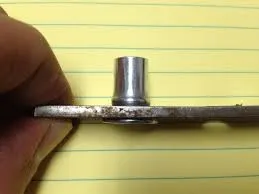
The grip range refers to the range of material thickness in which a rivet nut can be properly installed and securely fastened. This is typically specified in the product data sheet.
For example, a standard M6 round-body open-end rivet nut may have a grip range of 0.5mm – 3.0mm, meaning it is suitable for material thicknesses within that range.
If the material is thinner than 0.5mm, the rivet nut tail cannot expand properly and clamp the material, leading to spinning, pull-out, or thread failure.
If the material is thicker than 3.0mm, the rivet nut may not fully deform and anchor correctly, causing installation difficulty or distortion.
Selection tip: Always choose a grip range where your material thickness is in the middle of the range, avoiding extreme ends.
2. Structural Differences Among Rivet Nut Types
a. Round Body vs. Hex Body
Round Body Rivet Nuts: These have smooth or knurled cylindrical exteriors. They rely on friction after deformation to resist rotation. On very thin materials, friction area is limited, increasing the risk of spinning. Thicker material helps provide better support.
Hex Body Rivet Nuts: These require hexagonal holes and achieve anti-rotation through geometric interlock after installation. Their rotational resistance is stronger and can still perform reliably on thinner sheets, though the installation hole is harder to produce and is usually used in high-strength metal assemblies.
b. Open-End vs. Closed-End
Open-End Rivet Nuts: Threaded all the way through, suitable for through-hole designs. Their deeper deformation zone allows for wider grip range and often better performance in thinner materials.
Closed-End Rivet Nuts: The tail is sealed, preventing water, gas, or debris ingress. However, their expansion is more limited due to the closed back, so they often require thicker base material to ensure proper deformation and secure anchoring.
c. Small Flange vs. Large Flange
Reduced Head Rivet Nuts: With smaller flange diameter, they are ideal for confined or recessed spaces. However, due to their limited load-distribution area, they require thicker materials to resist pull-out or rotation.
Countersunk Head Rivet Nuts: These provide greater surface area to distribute the load and are better suited to thin or soft materials, enhancing stability. In thin sheet applications, large flange types are generally recommended.
3. Influence of Rivet Nut Material on Installation Behavior
Material Features: Soft and highly ductile, easy to deform, suitable for lightweight applications.
Minimum Thickness Adaptability: Because they deform easily, they can be securely installed even in very thin materials (e.g., 0.5mm). Ideal for low-load assemblies.
Limitations: Weaker pull-out resistance and wear strength. Not suitable for high-load or frequent-assembly scenarios.
Material Features: Strong and rigid with excellent mechanical lock performance.
Minimum Thickness Adaptability: Requires more installation force and adequate material thickness to support deformation. For thin sheets, risks include improper clamping or base material deformation. Generally recommended for ≥0.6mm material.
Applications: Widely used in industrial equipment, automotive parts, and structural assemblies.
Material Features: High strength and hardness with excellent corrosion resistance; ideal for harsh environments.
Minimum Thickness Adaptability: Due to high hardness and lower ductility, more force is needed to deform. Requires thicker material (usually ≥0.8mm) to ensure proper installation.
Applications: Suitable for outdoor, marine, corrosive, or heavy-duty environments such as communication towers or offshore equipment.
Summary: Key Factors That Determine the Minimum Thickness for a Rivet Nut
When determining the minimum base material thickness for rivet nut installation, consider the following:
Always check the grip range provided in the product specification and avoid installing outside of the recommended range.
Understand the structural characteristics of the rivet nut, including anti-rotation needs, flange size, and whether space is limited.
Select the appropriate material and tools to ensure proper expansion and reliable thread engagement.
What Is the Minimum Material Thickness for Different Rivet Nut Sizes?
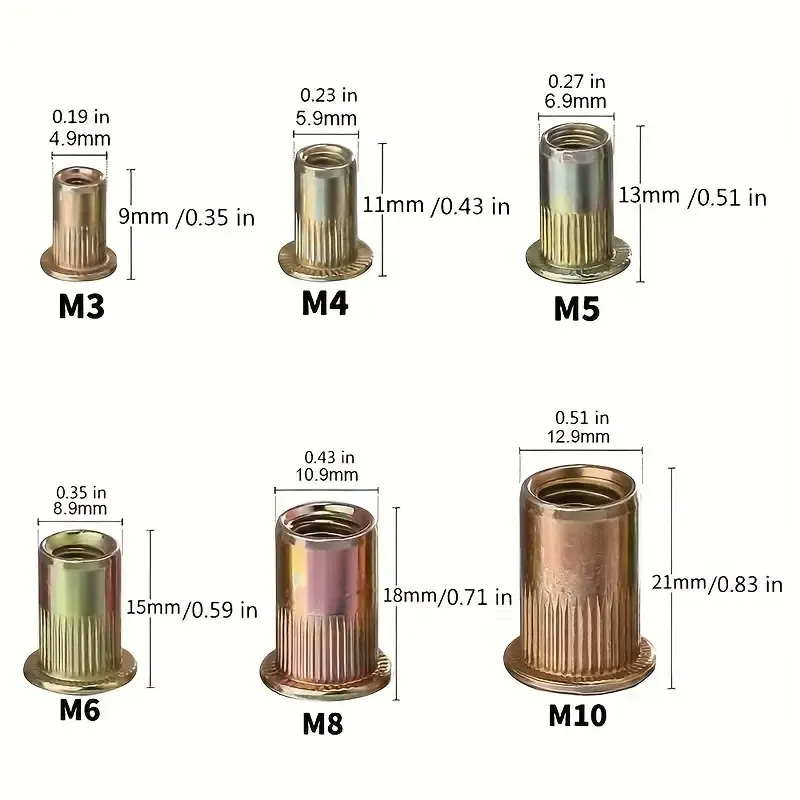
When selecting rivet nuts, understanding the minimum base material thickness they require is very important. If the material is too thin, the rivet nut may fail to form a stable deformation structure during installation, leading to pull-out, thread stripping, or rotation failure.
1. Why Is Minimum Thickness Important?
Rivet nuts rely on the plastic deformation of their tail section during installation to clamp the base material. If the sheet is too thin, it cannot provide enough resistance and deformation space, resulting in insecure fastening and potentially damaging the base material.
a. Ensuring Proper Clamping Deformation
The working principle of a rivet nut depends on the plastic expansion deformation of its tail during the pull-rivet process, firmly gripping the backside of the sheet. If the base material is too thin, the rivet nut may not generate sufficient reaction force to allow full deformation, causing installation failure or insufficient strength.
b. Preventing Base Material Tearing or Deformation
Installing rivet nuts on excessively thin sheets may cause the material to tear, punch through, or permanently bend during installation—especially when using harder materials like stainless steel rivet nuts. Choosing a suitable thickness helps protect the integrity of the base material.
c. Avoiding Rotation and Slippage Failures
For cylindrical or knurled rivet nuts, insufficient material thickness leads to reduced friction surface area, increasing the risk of the rivet nut rotating or slipping during use. This is especially critical in structures subjected to vibration or repeated torque.
d. Meeting Long-Term Load and Fatigue Life Requirements
Many rivet nuts are installed in load-bearing or vibration-prone applications. Thin sheets are less capable of maintaining clamping force over time, leading to loosening, fatigue, or thread failure. Adequate material thickness significantly improves connection longevity and structural safety.
2. Minimum Thickness Reference Table for Common Sizes
Below is a reference table of typical grip ranges and recommended minimum material thickness for common rivet nut sizes in both imperial and metric units:
| Rivet Nut Size (Imperial) | Typical Grip Range (inch) | Recommended Minimum Material Thickness (inch) | Rivet Nut Size (Metric) | Typical Grip Range (mm) | Recommended Minimum Material Thickness (mm) |
| 4-40 | 0.020 – 0.100 | 0.020 (≈0.5 mm) | M3 | 0.5 – 2.5 | 0.5 |
| 6-32 | 0.031 – 0.125 | 0.031 (≈0.8 mm) | M4 | 0.8 – 3.0 | 0.8 |
| 8-32 | 0.039 – 0.156 | 0.039 (≈1.0 mm) | M5 | 1.0 – 3.5 | 1.0 |
| 10-24 | 0.047 – 0.157 | 0.047 (≈1.2 mm) | M6 | 1.0 – 4.0 | 1.0 |
| 1/4-20 | 0.047 – 0.188 | 0.047 (≈1.2 mm) | M8 | 1.5 – 5.0 | 1.5 |
| 5/16-18 | 0.062 – 0.250 | 0.062 (≈1.6 mm) | M10 | 2.0 – 6.0 | 2.0 |
| 3/8-16 | 0.078 – 0.312 | 0.078 (≈2.0 mm) | M12 | 3.0 – 7.0 | 3.0 |
Detailed Notes:
- Grip Range: The material thickness range that the rivet nut is designed to reliably clamp. Installation requires material thickness within this range; too thin will not allow proper deformation, too thick will prevent full setting.
- Recommended Minimum Material Thickness: Suggested minimum thickness to ensure installation quality and service life, guaranteeing thread strength and stability.
- For very thin materials (below the recommended thickness), it is generally advised to use reinforced washers or specialized thin-sheet rivet nuts.
- Slight variations exist between different manufacturers’ specifications for some imperial and metric sizes, so always refer to the product datasheet when possible.
What Can You Do If the Base Material Is Too Thin?
1. Use Large Flange Rivet Nuts or Backing Plates to Increase Load Distribution
Thin sheet materials are prone to local deformation or tearing due to small surface area and low rigidity. In such cases, using Large Flange Rivet Nuts can help. Compared to standard small flange nuts, large flange types offer a broader contact surface, effectively dispersing the load and reducing the risk of base material deformation.
Another effective approach is to install a metal backing plate behind the base material. A backing plate with a typical thickness of 1–2 mm enhances the local rigidity of the sheet and improves the load-bearing capacity after the rivet nut is installed.
2. Design Sandwich Structures or Reinforcing Ribs
If the structure allows, consider adding a sandwich structure—an additional support layer in the area where the rivet nut is installed—so that the total material thickness meets the minimum grip requirement of the rivet nut.
For example, installing a 0.5 mm reinforcing plate on a 0.3 mm thin sheet allows you to use a rivet nut with a grip range of 0.5–2.5 mm. Additionally, reinforcing ribs can be added to the backside of the base material to further enhance strength and connection stability.
3. Use Special Rivet Nuts Designed for Thin Materials
Some manufacturers offer thin-sheet-specific rivet nuts designed for extremely thin materials (e.g., ≤0.5 mm). These rivet nuts feature optimized deformation structures that allow proper installation within a narrower material thickness range. For example, models with flanged lips or toothed designs can provide better bite into the thin sheet, improving installation reliability.
Conclusion - If the Base Material Is Too Thin
When dealing with insufficient base material thickness, it is not advisable to force standard rivet nuts into place, as this may lead to structural failure. Instead, consider solutions that focus on load distribution, structural reinforcement, and model optimization to ensure a reliable and durable rivet nut installation.
Conclusion
The minimum material thickness required for installing rivet nuts is not a fixed value—it depends on multiple key factors. During selection and application, it is crucial to comprehensively consider the following aspects:
1. Grip Range Is the Primary Reference
Each type and size of rivet nut comes with a specified grip range (minimum–maximum material thickness). For example, a standard M6 round open-end rivet nut may support 0.5–3.0 mm, but a closed-end or reinforced version might require a thicker base material. Therefore, always consult the product datasheet or technical specifications to ensure your material falls within the recommended grip range.
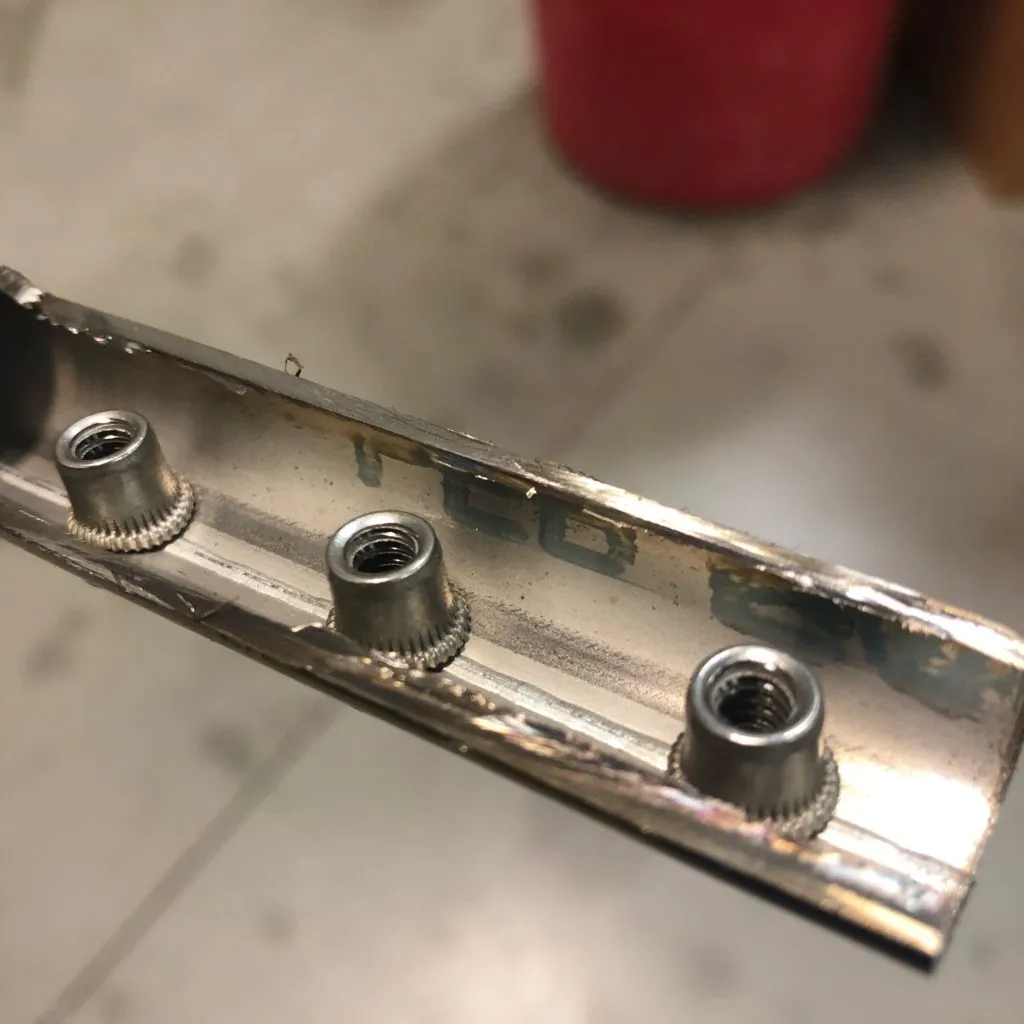
2. Rivet Nut Design and Material Affect the Minimum Thickness
The structural form—round vs. hex, open vs. closed-end, small vs. large flange—directly influences installation behavior and grip strength. For instance, hex-shaped nuts require a shaped hole; using them in thin material may lead to deformation and loss of anti-rotation capability. Softer base materials such as aluminum or stainless steel typically require a thicker substrate for proper anchoring.
3. Real-World Applications Require Strength and Safety Margins
Even if the material thickness technically meets the minimum requirement, it is advisable to allow for a safety margin in critical or high-load applications. Reinforcement methods such as backing plates or large flanges can help distribute load and prevent pull-through or deformation.
FAQs
a. What Is the Minimum Base Material Thickness Required for Installing Rivet Nuts?
The minimum material thickness for a rivet nut depends on its specific size (e.g., M3, M5, M8) and body type (e.g., round, knurled, hexagonal). Each rivet nut is designed with a defined grip range, which specifies the material thickness it can securely fasten.
For example:
An M3 rivet nut typically supports 0.5–2.5 mm grip range, and the recommended minimum thickness is ≥ 0.5 mm.
An M5 rivet nut usually fits 1.0–3.5 mm materials, with ≥ 1.0 mm as the minimum.
An M8 rivet nut is typically for thicker plates, requiring at least 1.5 mm.
If the base material is thinner than the recommended minimum, the rivet nut may not form proper deformation, leading to loose installation, weak threads, or spinning under torque.
2. What Happens If the Base Material Is Too Thin?
Using rivet nuts on materials thinner than their recommended range can lead to several serious problems that compromise the connection:
Improper Installation: The rivet nut’s rear section may not fully deform and clamp properly, resulting in a weak or failed joint.
Spinning Failure: Cylindrical or smooth-body rivet nuts may lack enough surface friction on thin material, causing them to spin during installation or usage.
Base Material Damage: Thin or soft plates can tear, deform, or bulge when a high-strength rivet nut (such as stainless steel) is forcefully installed.
Early Fatigue Failure: The joint may not withstand long-term loading or vibration and could loosen or break prematurely.
In summary, using rivet nuts on undersized material without proper reinforcement is risky and often leads to structural failure.
3. Are There Solutions for Using Rivet Nuts in Thin Sheet Metal?
Yes! If your base material is too thin, there are several ways to ensure secure rivet nut installation:
a. Use Large Flange Rivet Nuts
Large flange rivet nuts offer greater surface contact with the material than standard flange types. This helps distribute load more evenly and reduces the risk of pull-through, cracking, or deformation on thin plates (typically 0.5–1.0 mm).
b. Add a Backing Plate
Install a steel backing washer or reinforcement plate (1–2 mm thick) on the reverse side of the base material. This increases local rigidity and helps compensate for insufficient thickness.
c. Design Sandwich Structures or Reinforcement Ribs
When space permits, use a sandwich design—adding a secondary support plate to build up total material thickness at the mounting point. Alternatively, reinforce the back side with ribs or brackets to improve structural strength.
d. Choose Thin Sheet-Specific Rivet Nuts
Many manufacturers offer special thin sheet rivet nuts designed for ≤ 0.5 mm materials. These may feature optimized deformation geometry, knurled or toothed bodies, or special collars that enable firm clamping without damaging the thin substrate.
4. Why Is the Recommended Thickness Often Higher Than the Minimum Grip Range?
Although many rivet nuts can technically grip material as thin as 0.3–0.5 mm, their recommended minimum thickness is usually higher, for these reasons:
a. Safety Margin for Installation Tolerances
Variations in hole size, alignment, installation angle, or tool force can affect the quality of the joint. A higher material thickness provides better tolerance for real-world conditions.
b. Improved Anti-Rotation Resistance
Thicker material offers more surface area and friction, preventing round-body rivet nuts from spinning during use, especially under torque or vibration.
c. Better Long-Term Performance
In applications involving cyclic loading or mechanical stress (e.g., in vehicles or equipment), thinner material may lose preload or fatigue over time. Recommended thicknesses help ensure long-term durability.
d. Prevention of Material Damage
Stronger rivet nuts—like stainless steel or hardened steel—can deform or tear the base material if it’s too thin. Using the recommended thickness protects the integrity of the panel.
Do You Have Any Questions?
Let Us Solve Your Problem
Why Rivetfix Is Your Best Choice for High-Quality Rivet Nuts

As a leading fastener manufacturer in China with more than 15 years in the industry, Rivetfix are committed to providing first-class quality fasteners and responsive services to the world. We offers a wide range of rivet nuts and clinch nuts designed to meet the unique demands of your projects. Rivetfix ensures you have the right solution for every application. Choose Rivetfix for versatile, cost-effective, and durable fastening solutions tailored to your specific needs. In addition, we can also provide customized rivet nuts service and clinch nuts according to your requirements.
Contact us now for more information and customization options on Rivet Nuts!
Get High Quality Rivet Nuts Quote!
Send Your Rivet Nut Request
For more than 20 years, Rivetfix has helped customers solve many rivet nuts sourcing needs and technical challenges.
Have a question? Contact us and we’ll provide you with the perfect solution.



